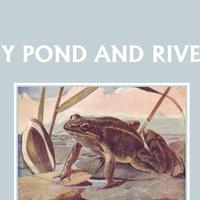CHAPTER 8. THE WATER-BUGS
WHEN you go home from school, if you pass a pond, you are almost sure to be able to find one, or more, of the three water-bugs of this lesson, and I want you to look at them.
The first is a long, thin, black insect. He walks on top of the water, looking like a needle on legs. He is sometimes called a "needle-bug," but more often a "water-measurer," because he seems to measure the water with his legs as he runs. He has very fine hairs under his body and on his legs. The air between these hairs prevents him from getting wet and being drowned. He has two long feelers, and a long thin beak. His legs and body are a reddish colour and his wings a glossy black.
If you watch him, you will see him start all at once across the pond. He is catching a water-fly. Then he will hold it in his front claws, and suck the juice out of its body. Though the water-measurer has wings, he does not often fly.
The next water-bug is not so thin. He is about an inch long, and has a flat body with grey wings folded across it. He has only very short feelers, and his front legs are thick and strong, with pincers at the end, and this is why he is called the "water-scorpion." He uses these pincers to seize the insects in the water, and sucks them dry through his sharp beak.
He swims under water very slowly, or crawls in the mud, and is easily caught. You may catch him too when he comes up to get air. This he does in a very funny way. He has two long bristles at the end of his tail. When he puts these together they make a tube like a hollow straw. He comes near the top of the water, and thrusts out the end of this tube into the air, and draws some into his body. The eggs of the mother water-scorpion are stuck on to the leaves of water-plants, and look like seeds.
The last water-bug I am sure you know. He is a little fellow, rather like a beetle, with six legs, two of them being very long ones; and he swims upside down, rowing himself along with these two legs, as if they were oars. This is why he is called a "water-boatman." He has a long, sucking beak, but you will hardly see it unless you dip him out with a glass and look close. For as he swims upside-down, the bug bends his head down on his chest, so that his beak lies between his legs.
His eyes at the side of his head are very large, so that he can look both down and up. This is very useful, for he swims under tadpoles and grubs, and catches them in his claws. Then he bites them with his sharp beak, and sucks out their soft body. He is always swimming in the water, or crawling in the mud. In the evening he sometimes comes out and flies to another pond or ditch.
The mother water-boatman lays small, long, white eggs on stems and leaves in the water. You may often find them in March, and in April you may see the little bugs swimming upside down like their parents.
If you take the trouble, you may catch these three water-bugs in a net, and put them in a glass, and see all I have told you.

